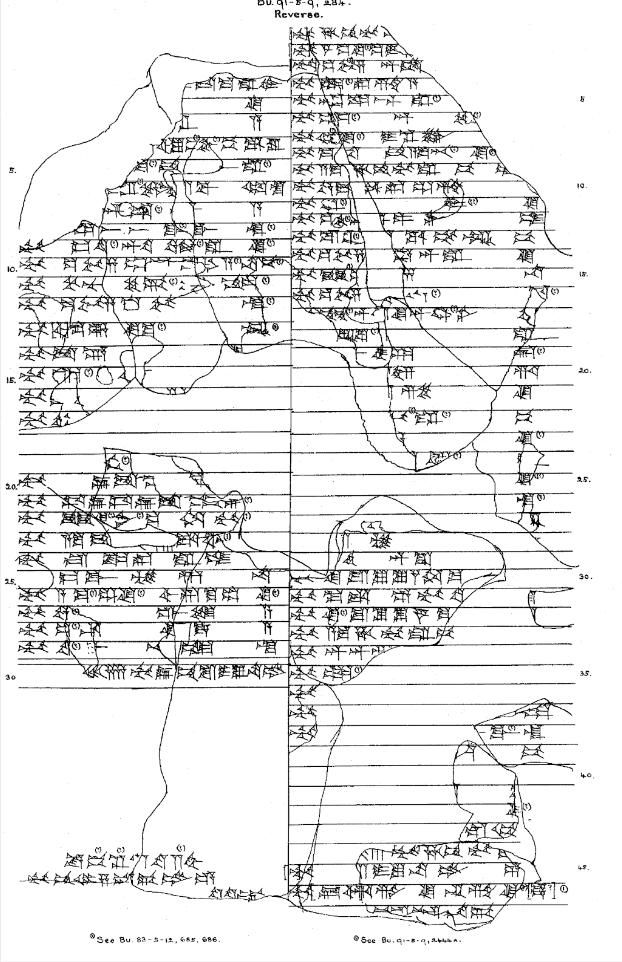Het bijhouden van jaarnamen

Fig. 1 - Handgetekende illustratie van een lijst van jaarnamen (British Museum, BM 92702), Samsu-iluna’s 38 jaar durende heerschappij aan de linkerkant. Elke jaarnaam begint met het teken MU “jaar”. In regel 30 staat het totaal aantal jaarnamen: 38 MU sa-am-su-i-lu-na LUGAL (=king). Het getal “38” is geschreven is met drie driehoekjes en acht horizontale lijntjes - T.G. Pinches, 1898, Cuneiform Texts from the British Museum Part 6, plate 10
Aan het begin van elk jaar verzamelde de Babylonische koning zijn adviseurs om te beslissen over de naam van het nieuwe jaar. Vaak werden jaren vernoemd naar een militair succes, zoals een gewonnen veldslag of een veroverde stad, bouwprojecten, zoals de aanleg van irrigatiekanalen, of de bouw van vestingen, of religieuze gebeurtenissen, zoals het offeren van een kostbaarstandbeeld, wapen of troon aan een godheid. Als een bepaald evenement was uitgekozen, verwerkten de klerken dat in een uitgebreide en poëtische naam van het jaar. Eenmaal af was de jaarnaam niet heel anders dan een koninklijk opschrift dat de koning en zijn daden prees. De klerken schreven zeker tientallen tabletten zoals LB 800 om op te sturen naar de koninklijke ambtenaren in de andere steden van het rijk. Zij zorgden er op hun beurt weer voor dat elke klerk in Babylonië de naam voor het nieuwe jaar zou weten.
In het alledaagse schrijven, bijvoorbeeld van administratieve documenten, was het niet altijd even praktisch om een volledige jaarnaam te moeten opschrijven, aangezien deze te lang was voor zulke doeleinden. In zulke gevallen kortten de klerken de jaarnamen af. De jaarnaam op LB 800, het 24e regeringsjaar van Samsu-iluna, werd afgekort naar: “Jaar: de stadsmuren van Kish”. Deze afgekorte versie vinden we op veel kleitabletten met spijkerschrift die in jaar 24 van Samsu-iluna gedateerd worden.
Maar hoe zou een Babylonische klerk een eeuw later weten dat dit Samsu-iluna jaar 24 was, of hoe zou de klerk weten wanneer Koning Hammurabi’s 10e jaar was? Hiervoor verzamelde de klerken de afgekorte jaarnamen in lange lijsten op chronologische volgorde. Als een klerk op een oud contract zou lezen “Jaar: het leger van Larsa werd verslagen”, raadpleegde hij of zij (veel vrouwen konden lezen en schrijven) een lijst met jaarnamen en zou ontdekken dat dit betrekking heeft op Hammurabi’s 31e jaar (ca. 1759 v.C.). Zulke lijsten zijn ook zeer informatief voor wetenschappers vandaag de dag, omdat ze een overzicht van de Babylonische geschiedenis per jaar weergeven.
Teksten zoals LB 800, zogeheten afkondigingsdocumenten, zijn uniek omdat ze de volledige versie van een jaarnaam bevatten. Zonder dit object zouden we slechts de afgekorte versie kennen en zouden we veel minder informatie hebben over de gebeurtenissen in dat jaar. Op het moment weten we van zo’n twintig dergelijke overgebleven afkondigingsdocumenten over de hele wereld.